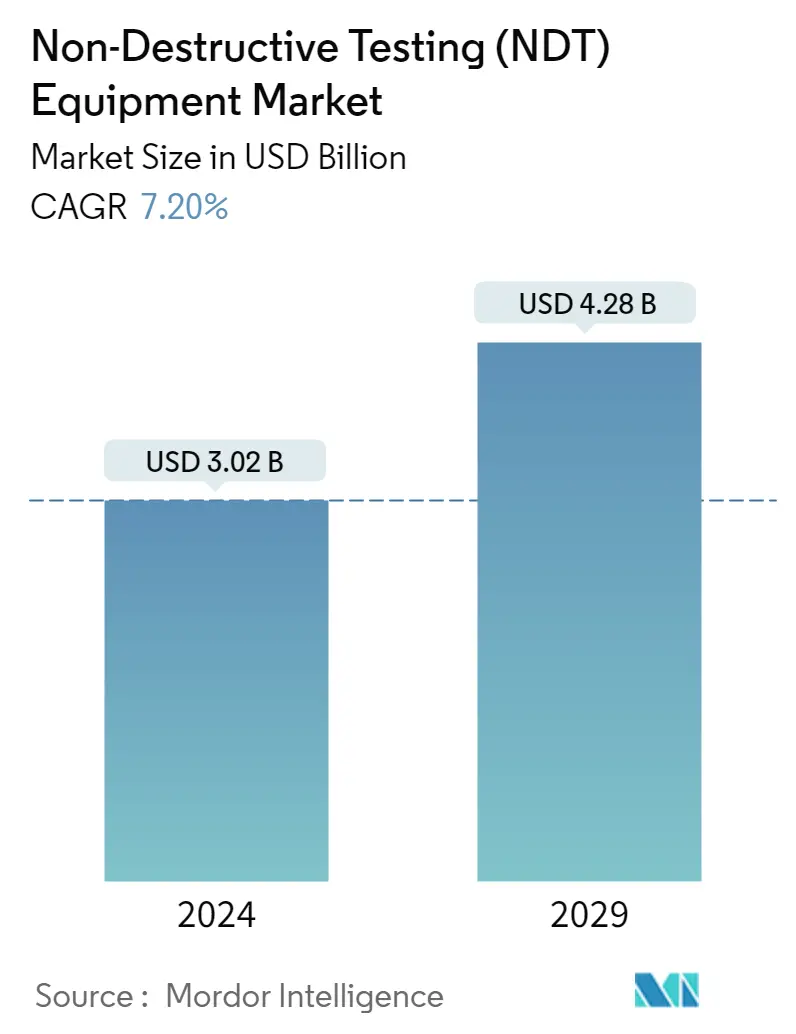Market Size of Non-Destructive Testing (NDT) Equipment Industry

| Study Period | 2019 - 2029 |
| Market Size (2024) | USD 3.02 Billion |
| Market Size (2029) | USD 4.28 Billion |
| CAGR (2024 - 2029) | 7.20 % |
| Fastest Growing Market | Asia Pacific |
| Largest Market | North America |
Major Players_Equipment_Market_Major_Players_.webp)
*Disclaimer: Major Players sorted in no particular order |
Need a report that reflects how COVID-19 has impacted this market and its growth?
Non-Destructive Testing Equipment Market Analysis
The Non-Destructive Testing Equipment Market size is estimated at USD 3.02 billion in 2024, and is expected to reach USD 4.28 billion by 2029, growing at a CAGR of 7.20% during the forecast period (2024-2029).
Non-destructive testing (NDT) involves the inspection, testing, or evaluation of components, materials, or assemblies. It involves examining disparities in characteristics or discontinuities, primarily without hampering the product's serviceability or part.
- The market sizing encompasses the revenue generated through the sales of different types of NDT equipment for different end-user industries such as oil and gas, power and energy, aerospace and defense, automotive & transportation, construction, etc. in different regions across the world. The study also tracks the key market parameters, underlying growth influencers, and major vendors operating in the industry, which supports the market estimations and growth rates over the forecast period.
- Several governmental agencies and regional bodies across the world formulated stringent measures, primarily for assuring the safety of buildings. These measures have mandated the use of NDT and other evaluation techniques for conducting fitness checks. This is important for gaining building clearances from concerned authorities for infrastructural projects. These checks include structural strength evaluation, fire safety, and emergency protocol compliance tests.
- NDT emerged as the most feasible method for monitoring the aging of structures periodically, in place of traditional methods. The restrictive cost and challenge of constructing new infrastructure resulted in the notable aging of existing structures and prompted companies to explore ways to extend the life of existing assets.
- There has been an incremental rise in the demand for skilled NDT technicians across the world. The demand currently outweighs the supply due to many reasons. Non-destructive testing can only be performed by certified professionals who undergo detailed training in the presence of subject-matter experts to gain expertise on the various techniques and skills involved in analyzing the data.
- During the beginning of the pandemic, lockdown measures significantly reduced electricity demand in the commercial and industrial sectors. The International Energy Agency (IEA) estimated that the global electricity demand would be decreased by 2.5% in Q1 2020, and it showed an approximately 5% contraction by the end of the year. This contraction ultimately resulted in the slowdown of expansion projects, which, in case, slowed down the requirement for radiography testing in the projects. After experiencing a steep decline in 2020, global electricity demand was expected to rebound modestly in 2021. With the recovery of the world economy in 2021, electricity demand was forecast to grow by around 3%. Moreover, the growth of renewable power generation was forecast to continue in 2021, with an increase of more than 6% .
